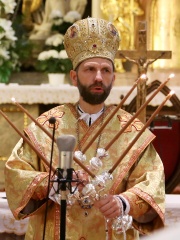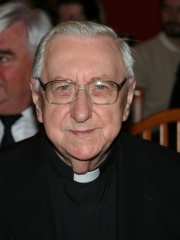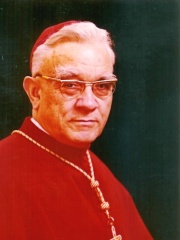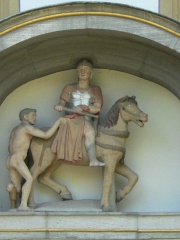
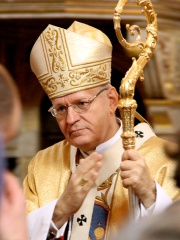
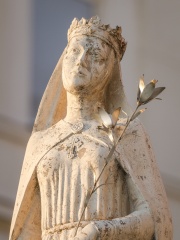

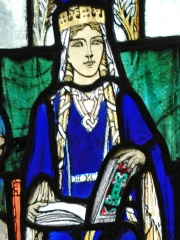
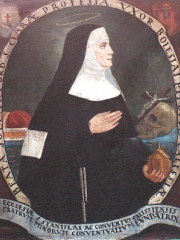
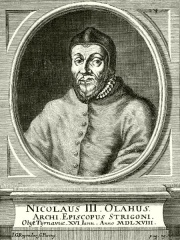
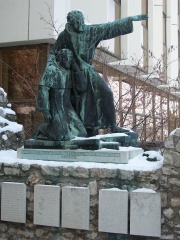
The Most Famous
RELIGIOUS FIGURES from Hungary
This page contains a list of the greatest Hungarian Religious Figures. The pantheon dataset contains 3,187 Religious Figures, 19 of which were born in Hungary. This makes Hungary the birth place of the 28th most number of Religious Figures behind Ireland, and Netherlands.
Top 10
The following people are considered by Pantheon to be the top 10 most legendary Hungarian Religious Figures of all time. This list of famous Hungarian Religious Figures is sorted by HPI (Historical Popularity Index), a metric that aggregates information on a biography's online popularity. Visit the rankings page to view the entire list of Hungarian Religious Figures.

1. Martin of Tours (316 - 397)
With an HPI of 81.41, Martin of Tours is the most famous Hungarian Religious Figure. His biography has been translated into 75 different languages on wikipedia.
Martin of Tours (Latin: Martinus Turonensis; 316/336 – 8 November 397) was the third bishop of Tours. He is the patron saint of many communities and organizations across Europe, including France's Third Republic. A native of Pannonia (present-day Hungary), he converted to Christianity at a young age. He served in the Roman cavalry in Gaul, but left military service prior to 361, when he became a disciple of Hilary of Poitiers, establishing the monastery at Ligugé. He was consecrated as Bishop of Caesarodunum (Tours) in 371. As bishop, he was active in the suppression of the remnants of Gallo-Roman religion. The contemporary hagiographer Sulpicius Severus wrote a Life of St. Martin. He is best known for the account of his using his sword to cut his cloak in two, to give half to a beggar clad only in rags in winter. His shrine in Tours became an often-frequented stop for pilgrims on the road to Santiago de Compostela in Spain.

2. Péter Erdő (b. 1952)
With an HPI of 70.94, Péter Erdő is the 2nd most famous Hungarian Religious Figure. His biography has been translated into 39 different languages.
Péter Erdő (Hungarian: Erdő Péter, pronounced [ˈɛrdøː ˈpeːtɛr]; born 25 June 1952) is a Hungarian cardinal of the Catholic Church who has served as the Archbishop of Esztergom-Budapest and Primate of Hungary since 2003. He was president of the Council of the Bishops' Conferences of Europe from 2006 to 2016. He was the relator general for the Third Extraordinary General Assembly of the Synod of Bishops in Rome. Erdő was seen as a leading candidate in the 2025 papal conclave. He gained significant support and was the favored choice of conservative Catholic networks in the United States and Hungarian Prime Minister Viktor Orbán, and has enjoyed good relations with the Orthodox churches and the Russian government.

3. Kinga of Poland (1224 - 1292)
With an HPI of 70.77, Kinga of Poland is the 3rd most famous Hungarian Religious Figure. Her biography has been translated into 35 different languages.
Kinga of Poland or Kinga of Hungary, also Saint Kinga (also known as Cunegunda; Polish: Święta Kinga, Hungarian: Szent Kinga, Lithuanian: Šv. Kunigunda) (5 March 1224– 24 July 1292) is a saint in the Catholic Church and patroness of Poland and Lithuania.

4. József Mindszenty (1892 - 1975)
With an HPI of 69.50, József Mindszenty is the 4th most famous Hungarian Religious Figure. His biography has been translated into 35 different languages.
József Mindszenty (Hungarian pronunciation: [jo:ʒɛf mindsɛnti]; 29 March 1892 – 6 May 1975) was a Hungarian cardinal of the Catholic Church who served as Archbishop of Esztergom and leader of the Catholic Church in Hungary from 1945 to 1973. According to the Encyclopedia Britannica, for five decades "he personified uncompromising opposition to fascism and communism in Hungary". During World War II, Mindszenty was imprisoned by the pro-Nazi Arrow Cross Party. After the war, he opposed communism and communist persecution in his country. As a result, he was tortured and given a life sentence in a 1949 show trial that generated worldwide condemnation, including a United Nations resolution. After eight years in prison, Mindszenty was freed in the Hungarian Revolution of 1956 and granted political asylum by the United States embassy in Budapest. He lived there for the next fifteen years. He was finally allowed to leave the country in 1971, and died in exile in 1975 in Vienna, Austria. His cause for sainthood was opened in 1993 and Pope Francis declared him Venerable in 2019.
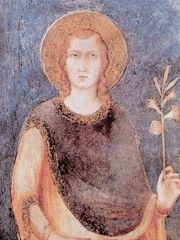
5. Saint Emeric of Hungary (1000 - 1031)
With an HPI of 67.21, Saint Emeric of Hungary is the 5th most famous Hungarian Religious Figure. His biography has been translated into 26 different languages.
Emeric (Hungarian: Szent Imre herceg), also Emericus, Emerick, Emery or Emory. Venerated as Saint Emeric (c. 1007 – 2 September 1031), was the son of King Stephen I of Hungary and Giselle of Bavaria.

6. Saint Margaret of Scotland (1045 - 1093)
With an HPI of 67.12, Saint Margaret of Scotland is the 6th most famous Hungarian Religious Figure. Her biography has been translated into 43 different languages.
Saint Margaret of Scotland (Scottish Gaelic: Naomh Maighréad; Scots: Saunt Marget, c. 1045 – 16 November 1093), also known as Margaret of Wessex, was Queen of Alba from 1070 to 1093 as the wife of King Malcolm III. Margaret was sometimes called "The Pearl of Scotland". She was a member of the House of Wessex and was born in the Kingdom of Hungary to the expatriate English prince Edward the Exile. She and her family returned to England in 1057. Following the death of Harold Godwinson at the Battle of Hastings in 1066, her brother Edgar Ætheling was elected King of England but never crowned. After the family fled north, Margaret married Malcolm III of Scotland by the end of 1070. Margaret was a pious Christian, and among many charitable works she established a ferry across the Firth of Forth in Scotland for pilgrims travelling to St Andrews in Fife, which gave the towns of South Queensferry and North Queensferry their names. Margaret was the mother of three kings of Scotland, or four, if Edmund of Scotland (who ruled with his uncle, Donald III) is counted, and of Matilda of Scotland, queen consort of England. According to the Vita S. Margaritae (Scotorum) Reginae (Life of St Margaret, Queen (of the Scots)), attributed to Turgot of Durham, Margaret died at Edinburgh Castle in 1093, days after receiving the news of her husband and son's deaths in battle. In 1250, Pope Innocent IV canonised Margaret, and her remains were reinterred in a shrine in Dunfermline Abbey in Fife. Her relics were dispersed after the Scottish Reformation and subsequently lost. Mary, Queen of Scots, at one time owned her head, which was subsequently preserved by Jesuits in the Scots College, Douai, France, from where it was lost during the French Revolution.

7. Yolanda of Poland (1235 - 1298)
With an HPI of 66.29, Yolanda of Poland is the 7th most famous Hungarian Religious Figure. Her biography has been translated into 20 different languages.
Yolanda of Poland or Yolanda of Hungary, also Blessed Yolanda (Jolanta in Polish; Jolán in Hungarian; also known as Helen; 1235 – 11 June 1298) was the daughter of King Béla IV of Hungary and Maria Laskarina. She was the sister of Margaret of Hungary and Kinga of Poland (Cunegunda). One of her paternal aunts was the Franciscan Elizabeth of Hungary.

8. Nicolaus Olahus (1493 - 1568)
With an HPI of 62.56, Nicolaus Olahus is the 8th most famous Hungarian Religious Figure. Her biography has been translated into 18 different languages.
Nicolaus Olahus (Latin for Nicholas, the Vlach; Hungarian: Oláh Miklós; Romanian: Nicolae Valahul); 10 January 1493 – 15 January 1568) was the Archbishop of Esztergom, Primate of Hungary, and a distinguished Catholic prelate, humanist and historiographer.

9. Friar Julian (b. 1250)
With an HPI of 60.69, Friar Julian is the 9th most famous Hungarian Religious Figure. His biography has been translated into 18 different languages.
Friar Julian (Hungarian: Julianus barát) was one of a group of Hungarian Dominican friars who, in 1235, left Hungary in order to find those Magyars who—according to the chronicles—remained in the eastern homeland. After travelling a great distance, Friar Julian reached the capital of Volga Bulgaria, where he was told that the Magyars lived only two days' travel away. Julian found them, and despite the gap of at least 300–400 years since the split between the Magyars that invaded and settled in Pannonia and those that were found in Bashkiria, their language remained mutually intelligible, and they were able to communicate. Julian named the old country Magna Hungaria. He became aware of stories about the Tatars, who were the enemies of the eastern Magyars and Bulgars. Two years after the original journey, Julian returned to Magna Hungaria, only to find it had been devastated by the Mongol Tatars. He returned to his kingdom with news of mortal danger and a Mongol ultimatum to Hungary. The Dominican order, established in Hungary in 1221 with the aim of evangelizing the East, simultaneously raised the issue of discovering the Hungarians who had remained on the native soil. Julian was the first in centuries to bring to Europe valid information about Hungarians living in Magna Hungaria, which contributes much to research on Hungarian history. He was also the first European traveler to gather valid information on Asia, and his descriptions are of great importance from the geographical aspect, which gave essential motivation to future European explorers and researchers. Julian was also the first to bring news of the upcoming Mongol invasion of Europe.
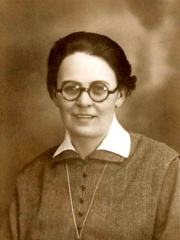
10. Sára Salkaházi (1899 - 1944)
With an HPI of 60.32, Sára Salkaházi is the 10th most famous Hungarian Religious Figure. Her biography has been translated into 26 different languages.
Sára Salkaházi, SSS (born Sarolta Klotild Schalkház; 11 May 1899 – 27 December 1944) was a Hungarian Catholic religious sister who saved the lives of approximately one hundred Jews during World War II. Denounced and summarily executed by the pro-Nazi Arrow Cross Party, Salkaházi was beatified in 2006.
People
Pantheon has 19 people classified as Hungarian religious figures born between 316 and 1963. Of these 19, 2 (10.53%) of them are still alive today. The most famous living Hungarian religious figures include Péter Erdő, and Péter Fülöp Kocsis. The most famous deceased Hungarian religious figures include Martin of Tours, Kinga of Poland, and József Mindszenty.
Living Hungarian Religious Figures
Go to all RankingsDeceased Hungarian Religious Figures
Go to all RankingsMartin of Tours
316 - 397
HPI: 81.41
Kinga of Poland
1224 - 1292
HPI: 70.77
József Mindszenty
1892 - 1975
HPI: 69.50
Saint Emeric of Hungary
1000 - 1031
HPI: 67.21
Saint Margaret of Scotland
1045 - 1093
HPI: 67.12
Yolanda of Poland
1235 - 1298
HPI: 66.29
Nicolaus Olahus
1493 - 1568
HPI: 62.56
Friar Julian
1250 - Present
HPI: 60.69
Sára Salkaházi
1899 - 1944
HPI: 60.32
László Paskai
1927 - 2015
HPI: 59.65
Vilmos Zsigmond
1930 - 2016
HPI: 59.47
László Lékai
1910 - 1986
HPI: 58.56
Overlapping Lives
Which Religious Figures were alive at the same time? This visualization shows the lifespans of the 10 most globally memorable Religious Figures since 1700.

